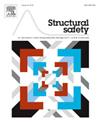A phase-control-based method for the simulation of homogeneous random fields of fluctuating wind speed
IF 6.3
1区 工程技术
Q1 ENGINEERING, CIVIL
引用次数: 0
Abstract
The simulation of stochastic processes, and of time-variant random fields finds extensive applications across various scientific and engineering domains. Despite the existence of a variety of methods, including the well-developed spectral representation method, it is still necessary to study the representation of the correlation structure of time-variant random fields. This paper proposes a phase control method for simulating correlated stochastic processes and spatiotemporal random fields. First, by introducing an auxiliary random phase angle and controlling its amplitude, the correlation of two stochastic processes can be precisely reproduced by introducing the auxiliary phase angle to the original process. Further, for time-variant random field simulation, the correlation structure of the random field is converted into that of the random phase angle field, thereby making it possible for the random field simulation either by phase shifting from a single process or using the spectral representation method in a decoupled manner. The effectiveness of the proposed method is validated by two numerical examples of fluctuating wind field simulation. This method provides an alternative perspective on the correlation structure of random fields and could be used for conditional simulation of random fields in future work.
基于相位控制的脉动风速均匀随机场模拟方法
随机过程和时变随机场的模拟在各种科学和工程领域中有着广泛的应用。尽管存在多种方法,包括发展完善的谱表示方法,但仍有必要研究时变随机场相关结构的表示。本文提出了一种相位控制方法来模拟相关随机过程和时空随机场。首先,通过引入辅助随机相角并控制其幅值,通过在原过程中引入辅助相角,可以精确再现两个随机过程的相关性。此外,对于时变随机场模拟,将随机场的相关结构转换为随机相角场的相关结构,从而可以通过从单个过程移相或使用解耦的谱表示方法进行随机场模拟。通过两个脉动风场数值模拟实例验证了该方法的有效性。该方法为研究随机场的相关结构提供了另一种视角,可用于未来工作中随机场的条件模拟。
本文章由计算机程序翻译,如有差异,请以英文原文为准。
求助全文
约1分钟内获得全文
求助全文
来源期刊

Structural Safety
工程技术-工程:土木
CiteScore
11.30
自引率
8.60%
发文量
67
审稿时长
53 days
期刊介绍:
Structural Safety is an international journal devoted to integrated risk assessment for a wide range of constructed facilities such as buildings, bridges, earth structures, offshore facilities, dams, lifelines and nuclear structural systems. Its purpose is to foster communication about risk and reliability among technical disciplines involved in design and construction, and to enhance the use of risk management in the constructed environment
 求助内容:
求助内容: 应助结果提醒方式:
应助结果提醒方式:


